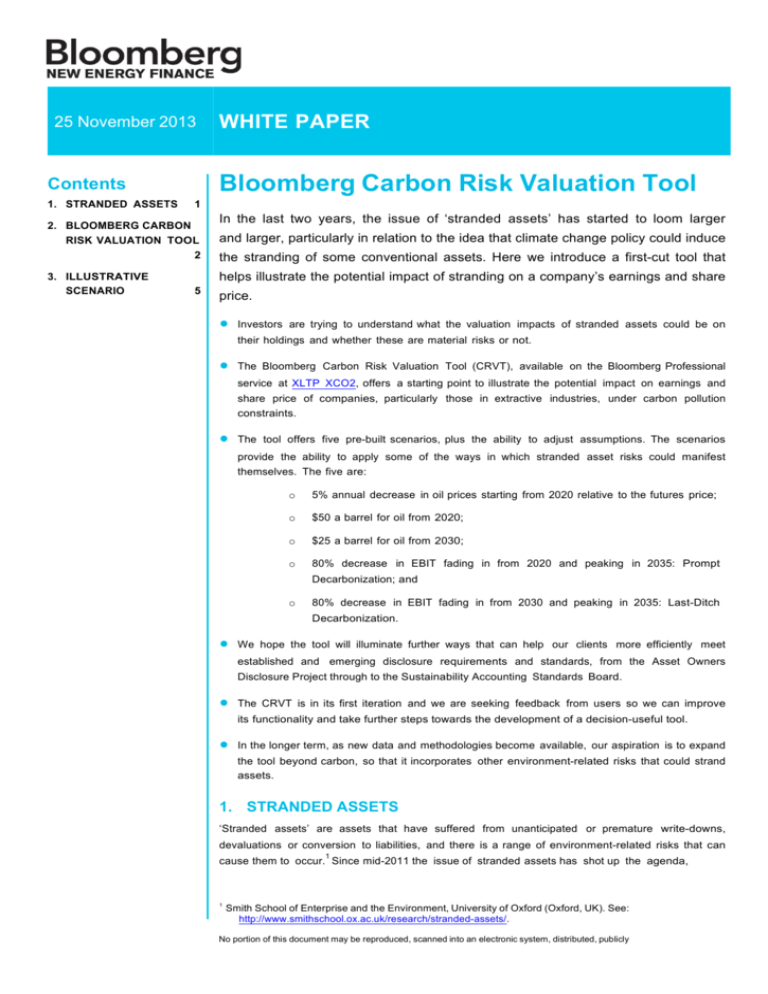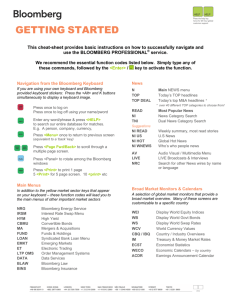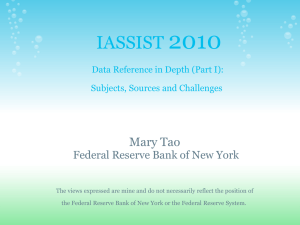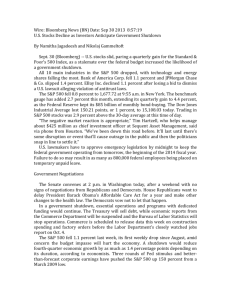Bloomberg Carbon Risk Valuation Tool
advertisement

25 November 2013 WHITE PAPER Bloomberg Carbon Risk Valuation Tool Contents 1. STRANDED ASSETS 1 2. BLOOMBERG CARBON RISK VALUATION TOOL 2 3. ILLUSTRATIVE SCENARIO In the last two years, the issue of ‘stranded assets’ has started to loom larger and larger, particularly in relation to the idea that climate change policy could induce the stranding of some conventional assets. Here we introduce a first-cut tool that helps illustrate the potential impact of stranding on a company’s earnings and share 5 price. ● Investors are trying to understand what the valuation impacts of stranded assets could be on their holdings and whether these are material risks or not. ● The Bloomberg Carbon Risk Valuation Tool (CRVT), available on the Bloomberg Professional service at XLTP XCO2, offers a starting point to illustrate the potential impact on earnings and share price of companies, particularly those in extractive industries, under carbon pollution constraints. ● The tool offers five pre-built scenarios, plus the ability to adjust assumptions. The scenarios provide the ability to apply some of the ways in which stranded asset risks could manifest themselves. The five are: o 5% annual decrease in oil prices starting from 2020 relative to the futures price; o $50 a barrel for oil from 2020; o $25 a barrel for oil from 2030; o 80% decrease in EBIT fading in from 2020 and peaking in 2035: Prompt Decarbonization; and o 80% decrease in EBIT fading in from 2030 and peaking in 2035: Last-Ditch Decarbonization. ● We hope the tool will illuminate further ways that can help our clients more efficiently meet established and emerging disclosure requirements and standards, from the Asset Owners Disclosure Project through to the Sustainability Accounting Standards Board. ● The CRVT is in its first iteration and we are seeking feedback from users so we can improve its functionality and take further steps towards the development of a decision-useful tool. ● In the longer term, as new data and methodologies become available, our aspiration is to expand the tool beyond carbon, so that it incorporates other environment-related risks that could strand assets. 1. STRANDED ASSETS ‘Stranded assets’ are assets that have suffered from unanticipated or premature write-downs, devaluations or conversion to liabilities, and there is a range of environment-related risks that can 1 cause them to occur. Since mid-2011 the issue of stranded assets has shot up the agenda, 1 Smith School of Enterprise and the Environment, University of Oxford (Oxford, UK). See: http://www.smithschool.ox.ac.uk/research/stranded-assets/. No portion of this document may be reproduced, scanned into an electronic system, distributed, publicly WHITE particularly in relation to the idea that climate change policy could induce stranded assets if governments live up to their commitments to keep global warming below 2 degrees. 2 Perhaps the thing that has done the most to propel the idea into the public consciousness and on to the agenda for many businesses and investors was the publication on 19 July 2012 by Rolling 3 Stone of an article by Bill McKibben titled ‘Global Warming’s Terrifying New Math’ . In this article McKibben explains that in order to have an 80% chance of keeping global warming below 2°C (the target agreed to by the 167 countries that signed the Copenhagen Accord in 2009), we can only emit 565 gigatons of carbon dioxide (GtCO2) between 2010 and 2050. By contrast, burning all the currently proven oil, gas and coal reserves of fossil fuel companies would release 2,795GtCO2 into the atmosphere. This is almost five times the ‘carbon budget’ of 565GtCO2. The idea of such a carbon budget and a consequent ‘carbon bubble’ in the financial system has spurred on a fossil fuel divestment campaign that has been remarkably successful at gaining traction within a short period of time. 4 On the back of this campaign and the emergent stranded assets agenda, Storebrand – a major Norwegian and Swedish pension fund with $74bn of assets – decided to divest from all its coal investments in July 2013. This was one of the first large investors to reduce portfolio exposure to fossil fuel assets as a result of concerns over stranded assets. Others are likely to follow. In response to 1) a growing interest among investors and investee companies, many of whom are Bloomberg clients, in carbon and other environment-related risks as a driver of stranded assets and 2) a shortage of analytical tools for practitioners to conduct meaningful research in a cost effective way, we have embarked on the development of a new tool that is now available through the Bloomberg Professional service. This short note explains the tool and its underlying assumptions. We also show an illustrative example of the tool in action. 2. BLOOMBERG CARBON RISK VALUATION TOOL Investors are trying to understand what the valuation impacts of ‘stranded assets’ could be on their holdings and whether these are material risks or not. The Bloomberg Carbon Risk Valuation Tool (CRVT), available on the Bloomberg Professional service terminal at XLTP XCO2, provides a general view into the potential impact of asset stranding on earnings and share price of companies, particularly those in extractive industries, under carbon pollution constraints. The CRVT offers several pre-built carbon constraint scenarios that the user can run, as well as the ability to manipulate the underlying assumptions for how carbon constraints might be applied and the price of oil and gas, as well as a company's cost of producing and developing new oil and gas reserves. In addition to interrogating the revenue and costs from extracting fossil fuels, the tool offers the ability to model the energy and carbon costs of shifting to harder to find, more carbon-intensive resource extraction. 2 3 4 th Caldecott, B.L. (2011) Why high carbon investment could be the next sub-prime crisis. The Guardian, 12 July 2011. See: http://www.guardian.co.uk/environment/2011/jul/12/high-carbon-investment; Stern, N. th (2011) A profound contradiction at the heart of climate change policy. The Financial Times, 8 December 2011. See: http://www.ft.com/cms/s/0/52f2709c-20f0-11e1-8a43-00144feabdc0.html#ixzz1g1WNryuV; and Carbon Tracker Initiative (2011) Unburnable Carbon: Are the world’s financial markets carrying a carbon bubble? See: http://www.carbontracker.org/wp-content/uploads/downloads/2011/07/UnburnableCarbon-Full-rev2.pdf; Generation Investment Management (2012) Sustainable Capitalism. See: http://www.generationim.com/media/pdf-generation-sustainable-capitalism-v1.pdf; Generation Investment Management (2013) Stranded Carbon Assets: Why and how carbon risks should be incorporated in investment analysis. See: http://genfound.org/media/pdf-generation-foundation-stranded-carbon-assetsv1.pdf. McKibben, B. (2012) ‘Global Warming’s Terrifying New Math’. Rolling Stone. See: http://www.rollingstone.com/politics/news/global-warmings-terrifying-new-math-20120719. Ansar, A., Caldecott, B.L., & Tilbury, J. (2013) Stranded Assets and the fossil fuel divestment campaign: what does divestment mean for the valuation of fossil fuel assets? Smith School of Enterprise and the Environment, University of Oxford (Oxford, UK). No portion of this document may be reproduced, scanned into an electronic system, distributed, publicly WHITE Figure 1: CRVT Screenshots The tool relies on consensus earnings estimates data and standard financial metrics to build out a full income and cash flow statement for a company. From there, the user can choose a valuation model to derive a fair-value share price, including a discounted cash flow, earnings multiple, and reserves multiple model. All of the data and assumptions are fully transparent and can be overridden and tailored in a bespoke way by the user. In addition, the tool provides information about potential future debt coverage ratios. It is hoped that the CRVT will provide a starting point for Bloomberg users interested in assessing the impacts of carbon exposure on investee companies and across portfolios. This type of analysis typically requires either engaging a third party to undertake a bespoke analysis or investing significant internal resources to complete such an investigation. Our tool offers a first-cut attempt to simplify this process and illuminate a more efficient way for Bloomberg users to begin to do this work. As well as reducing the cost and barriers to entry, we also hope the tool illuminates ways for our clients to more efficiently satisfy established and emerging disclosure requirements and standards, from the Asset Owners Disclosure Project through to the Sustainability Accounting Standards Board. The CRVT is in its first iteration and we are seeking feedback from users so we can improve its functionality. As new data and methodologies become available, our aspiration is to make the carbon tool more effective and in the longer-term, expand beyond carbon, so that it incorporates other environment-related risks that could strand assets. We also want to develop the CRVT so that it easily allows portfolios of companies and indices to be stress-tested against different carbon constraints. The role of oil and gas price shocks At the heart of the CRVT is the provision of information about what could happen to company earnings if the price of oil or gas were to deviate from the futures price. It does this in two ways. First, if we assume that oil prices fall below the expected futures price due to a decrease in demand, then a company would have a decrease in top-line revenue and bottom-line earnings. The model assumes this is an exogenous shock with no other impacts. This assumption is based on the idea that a change in oil prices would have no impact on the actual cost of extracting the oil. No portion of this document may be reproduced, scanned into an electronic system, distributed, publicly WHITE Second, the model looks at the cost structure of a company and what it would do in the face of decreasing oil prices. Bloomberg collects data on company reserves and exploration and production costs. The tool relies on Bloomberg data for the average lifting costs per barrel of oil equivalent, the cost to extract a barrel of oil, the average finding and development costs per barrel of oil equivalent and the exploration costs to add an additional barrel of oil. The model assumes that if the price of oil falls below the lifting cost per barrel, that the company in question will stop producing oil. Simply, if it costs more to pull the oil out of the ground than the company will earn, the company will not extract. The tool deducts these company earnings from the expected earnings for the company. The model does not make any other assumptions about a company’s earnings. For example, integrated oil majors have significant earnings from their refining and petrochemical businesses. It is assumed that these revenues are unchanged, but users are able to use their own assumptions based on their view of what could happen. The other angle the model looks at is to consider the issue of ‘wasted capital’ when the price of oil falls below the lifting and exploration and development costs for a company. If a company realistically expected oil prices not to recover again, the logical course of action would be to stop searching for oil. Alternatively, if the company thought the price drop was temporary, it could keep carrying on as usual and devote capital expenditure to searching for new oil and gas opportunities. The tool allows the user to toggle between two options: 1) where the company continues capex on exploration, or 2) returns the capex money to shareholders when it is no longer economical to keep searching. 2.1. Tool scenarios The tool offers five pre-built scenarios, plus the ability to adjust assumptions. The scenarios provide the ability to apply some of the ways in which stranded asset risks could manifest themselves. The five are: • 5% annual decrease in oil prices starting from 2020 relative to the futures price; • $50 a barrel for oil from 2020 (based on the $50-a-barrel assumption used by Spedding, Mehta, and Robins, Oil & Carbon Revisted: Value at risk from 'unburnable' reserves. HSBC Global Research. 25 January 2013.); • $25 a barrel for oil from 2030; • 80% decrease in EBIT fading in from 2020 and peaking in 2035: Prompt Decarbonization (based on the notion that 80% of fossil fuel reserves will need to stay in the ground); and • 80% decrease in EBIT fading in from 2030 and peaking in 2035: Last-Ditch Decarbonization. 2.2. Carbon costs The tool includes functionality to test how changes in emissions and resource intensity levels and prices could impact financial returns. Climate change regulation would increase the cost of carbon emissions, negatively impacting company earnings. Additionally, the move to harder to reach, more carbon-intensive oil extraction (e.g. tar sands) could increase the carbon emissions of companies involved in such activities. Also, changes in energy requirements could impact costs. The cost implications are not entirely negative. If a company can increase its resource efficiency, this would have a positive impact on earnings. Alongside carbon and energy costs, users can model the financial impact of energy, water, waste, and wastewater costs. 2.3. Model limitations With any model, it is important to acknowledge its limitations. The model looks only at the average lifting and exploration and development costs for companies as that is generally what tends to be publicly reported. For a company with only a couple of different oil fields that is probably No portion of this document may be reproduced, scanned into an electronic system, distributed, publicly WHITE adequate, but for a company with a diverse range of projects, it is problematic. Ideally instead of the binary assumption that a company either produces oil or it does not, one would want to understand the breakeven price at which a company would stop operating each individual field. Table 1: IOCs analysed and gas exploration or return the money to shareholders. Realistically, companies would find Company Market cap ($bn) Another limitation is the binary assumption that a company can either keep spending capex on oil other avenues they could invest in, perhaps renewables or something different. This is where it Exxon 393.8 Petrochina 232.5 Chevron 231.7 Royal Dutch Shell 215.0 BP 145.2 assumptions used by the CRVT in this example and the following charts shows the modelled Total 144.8 impact of the five pre-built scenarios on the share prices of eight of the largest listed International Petrobras 114.9 Oil Companies (IOCs) by market cap (Table 1). Ecopetrol 98.1 CNOOC 91.7 becomes important to understand how firms would invest in the future at different oil price points. 3. ILLUSTRATIVE SCENARIO Below we have included an illustrative example of the model in action. Table 2 shows the Source: Bloomberg New Energy Finance. Note: data as of 30 Oct Table 2: Assumptions Price, cost and economics Oil prices All firms receive WTI price as observed from futures curve. From 2019 on prices grow at growth rate equal to the price change in the year of Gas prices All firms receive HH price as observed from futures curve. From 2019 on prices grow at growth rate equal to the price change in the year of 2013. Oil & gas production We've set the default equal to the EIA's global production forecast, but in reality it should unique for both oil & gas and to each Oil reserves Grows at 'growth rate' = 2.5% - derived from US year T Oil purchases sales & other charges Grows at 'growth rate' = 2.5% - derived from US year T Gas reserves Grows at 'growth rate' = 2.5% - derived from US year T Gas purchases sales & other charges Grows at 'growth rate' = 2.5% - derived from US year T O&G lifting costs Grows at 'growth rate' = 2.5% - derived from US year T O&G finding and development costs Grows at 'growth rate' = 2.5% - derived from US year T Oil & gas production mix Exploration economics Remains stable at 2012 mix Companies keep searching for oil (keep incurring F&D costs) even when it's no longer economical Environmental costs Source: Bloomberg New Energy Finance To first position the companies being analysed, we show in Figure 1 the percentage of each IOC's output that is attributable to oil production. This chart helps illustrate current operational characteristics, but does not provide clarity on key variables like the size and growth rate of company reserves, which end up having a large impact in decarbonisation scenarios. No portion of this document may be reproduced, scanned into an electronic system, distributed, publicly WHITE Figure 1: Oil production as a percentage of total company output (%) Royal Dutch Shell PLC Exxon Mobil Corp Total SA BP PLC Chevron Corp PetroChina Co Ltd CNOOC Ltd Ecopetrol SA Petroleo Brasileiro SA 0% 20% 40% 60% 80% 100% Source: Bloomberg, Company Filings When the model is run for each of the scenarios, the resulting share prices reflect the hypothetical current value of each company’s shares given the specific constraints applied for each carbon scenario. The assumption is that these decarbonisation facts would be immediately priced into each company’s shares. The degree of this impact varies and is dependent on the interaction of a number of key variables, which differ by company. However - due to the application of the discounted cashflow model applied in our analysis, it is the nearest-term scenarios with the most severe decarbonisation implications that have the most adverse effect on share prices. In Figure 2, we see these results in USD/share form. For this illustrative analysis all financials are converted to USD first before valuation, which results in a difficult to read picture of the companyspecific effects of asset stranding – as share prices are difficult to compare due to differing USD/share valuations. Figure 2: Share prices – change from current price as a result of stranded asset scenarios ($/share) 140 Current Price 120 5% decline from 2020 100 80 $50 from 2020 60 $25 from 2030 40 20 0 Exxon Mobil PetroChina PetroChina ExxonMobil Corp Co Ltd Chevron Chevron Corp Dutch Total Total SA SA Royal Dutch Shell PLC BP PLC PLC BP Petroleo Petroleo Brasileiro SA Ecopetrol Ecopetrol CNOOC CNOOC Ltd Ltd SA Prompt Decarbonization Last-Ditch Decarbonization Source: Bloomberg New Energy Finance In Figure 3, we break this analysis into a more easily compared valuation based on the percentage change from current local currency share price (as calculated by our DCF model). What becomes apparent is that the oil and gas price shock scenarios tend to have a similarly strong negative impact on share prices, although the degree of that impact varies by company. No portion of this document may be reproduced, scanned into an electronic system, distributed, publicly WHITE On the other hand, the last-ditch decarbonisation scenario has the smallest effect across the board as the timeline for application of its effects is far enough out that the discounted effects of the scenario on company cashflows are mitigated by the time horizon - and in some cases result in little to no impact. It should be noted that this impact is not to be taken lightly, as even the heavy discounts applied to future cashflows cannot mask the negative effects of decarbonisation. In terms of average impact on share price, the $50 oil price from 2020 scenario results in the most adverse decline – bringing shares down an average of 58%, followed by the 5% price decline from 2020 scenario, which has an average impact of -54%. The $25 from 2030 scenario results in the most mixed outcome. Figure 3: Share prices – change relative to model fair value as a result of stranded asset scenarios (%) 120 Model Price 100 5% decline from 2020 80 $50 from 2020 60 40 $25 from 2030 20 0 ExxonMobil PetroChina Exxon Mobil PetroChina Corp Co Ltd Chevron Royal Royal Dutch Dutch Total SA Corp Shell PLC BPPLC PLC BP Petroleo Petroleo Brasileiro SA Ecopetrol CNOOC Ltd SA Source: Bloomberg New Energy Finance No portion of this document may be reproduced, scanned into an electronic system, distributed, publicly Prompt Decarbonization Last-Ditch Decarbonization WHITE ABOUT US SUBSCRIPTION DETAILS White Paper sales.bnef@bloomberg.net CONTACT DETAILS Ben Caldecott, Bloomberg New Energy Finance bcaldecott1@bloomberg.net +44 203 525 8876 Gregory Elders, Bloomberg ESG gelders2@bloomberg.net +44 203 525 8295 COPYRIGHT © Bloomberg Finance L.P. 2013. No portion of this document may be reproduced, scanned into an electronic system, distributed, publicly displayed or used as the basis of derivative works without the prior written consent of Bloomberg Finance L.P. DISCLAIMER This service is derived from selected public sources. Bloomberg Finance L.P. and its affiliates, in providing the service, believe that the information it uses comes from reliable sources, but do not guarantee the accuracy or completeness of this information, which is subject to change without notice, and nothing in this document shall be construed as such a guarantee. The statements in this service reflect the current judgment of the authors of the relevant articles or features, and do not necessarily reflect the opinion of Bloomberg Finance L.P., Bloomberg L.P. or any of their affiliates (“Bloomberg”). Bloomberg disclaims any liability arising from use of this document and/or its contents, and this service. Nothing herein shall constitute or be construed as an offering of financial instruments or as investment advice or recommendations by Bloomberg of an investment or other strategy (e.g., whether or not to “buy”, “sell”, or “hold” an investment). The information available through this service is not based on consideration of a subscriber’s individual circumstances and should not be considered as information sufficient upon which to base an investment decision. BLOOMBERG, BLOOMBERG PROFESSIONAL, BLOOMBERG MARKETS, BLOOMBERG NEWS, BLOOMBERG ANYWHERE, BLOOMBERG TRADEBOOK, BLOOMBERG BONDTRADER, BLOOMBERG TELEVISION, BLOOMBERG RADIO, BLOOMBERG PRESS, BLOOMBERG.COM, BLOOMBERG NEW ENERGY FINANCE and NEW ENERGY FINANCE are trademarks and service marks of Bloomberg Finance L.P. or its subsidiaries. This service is provided by Bloomberg Finance L.P. and its affiliates. The data contained within this document, its contents and/or this service do not express an opinion on the future or projected value of any financial instrument and are not research recommendations (i.e., recommendations as to whether or not to “buy”, “sell”, “hold”, or to enter or not to enter into any other transaction involving any specific interest) or a recommendation as to an investment or other strategy. No aspect of this service is based on the consideration of a customer’s individual circumstances. You should determine on your own whether you agree with the content of this document and any other data provided through this service. Employees involved in this service may hold positions in the companies covered by this service. No portion of this document may be reproduced, scanned into an electronic system, distributed, publicly






